HI6028 Taxation Law: Capital Gains and Fringe Benefits Analysis
VerifiedAdded on 2023/06/07
|11
|2355
|259
Homework Assignment
AI Summary
This assignment provides a detailed analysis of capital gains tax (CGT) and fringe benefits tax (FBT) implications based on provided scenarios. The first question involves calculating net capital gains or losses from the sale of a vacant land, an antique bed, a painting, shares and a violin, considering CGT exemptions, discounts, and prior year losses. The second question examines the fringe benefits consequences for an employer (Rapid Heat) providing car, loan, and internal expense benefits to an employee (Jasmine), calculating FBT liabilities and potential deductions. The assignment references relevant sections of the ITAA 1997 and FBTAA 1986, along with various tax rulings and case laws to support the analysis and conclusions.
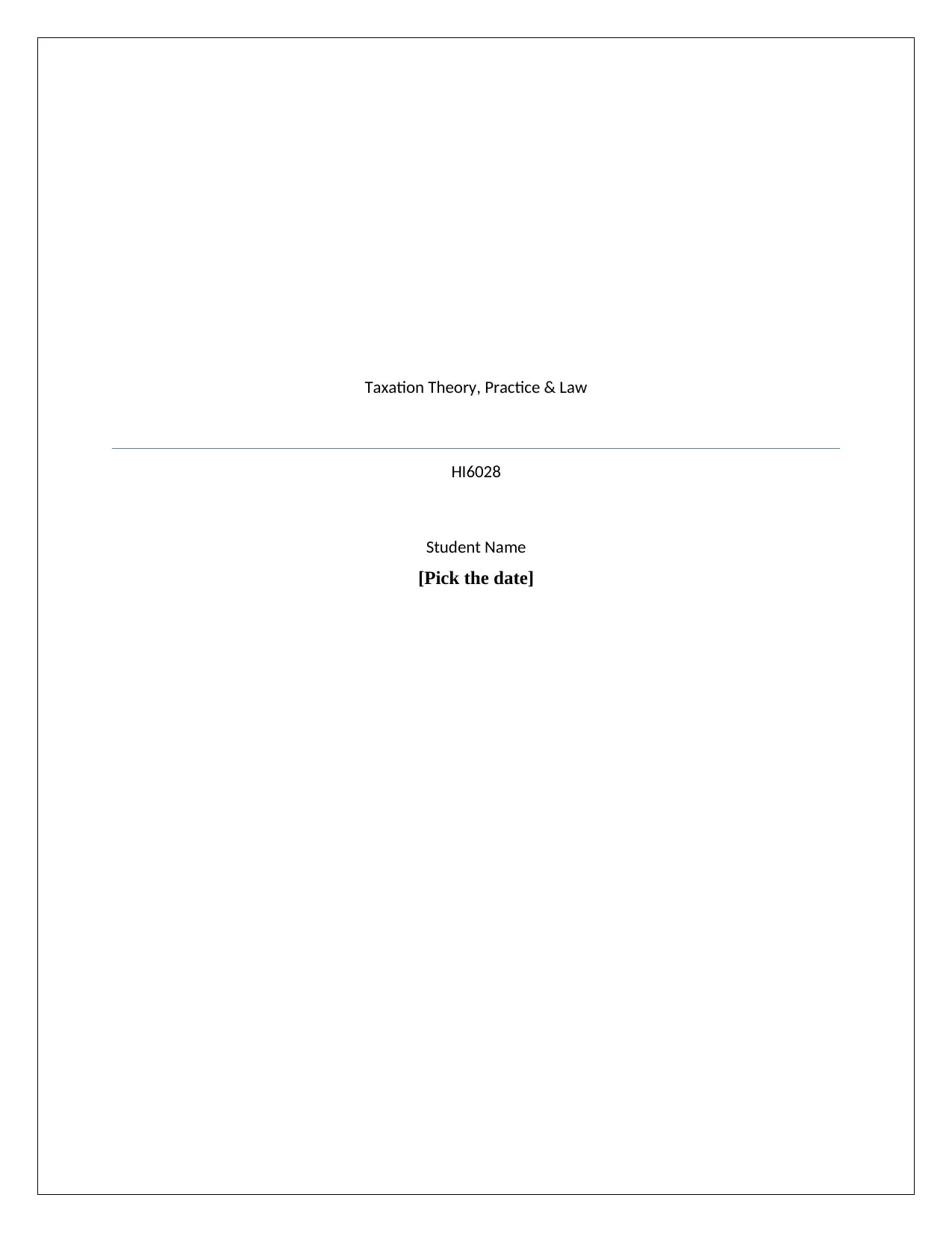
Taxation Theory, Practice & Law
HI6028
Student Name
[Pick the date]
HI6028
Student Name
[Pick the date]
Paraphrase This Document
Need a fresh take? Get an instant paraphrase of this document with our AI Paraphraser

Question 1
The objective of the given scenario is to compute the net capital gain or capital loss for the given
client who is not only an investor but also an antique collection. The relevant capital gains
implications of the various transactions that have been enacted in the given tax year are as
presented below.
Block of Vacant Land
Section 149-10 ITAA 1997 states that any asset that has been acquired before September 20,
1985 would be a pre-CGT asset and hence exempt from Capital Gains Tax (CGT). It is apparent
that the given block of land has been purchased in January 2001, hence the land would not be
considered a pre-CGT asset (Barkoczy, 2017).
Section 104-5 states that the underlying transaction is an A1 event whereby a CGT asset in the
form of land block has been sold. The capital gains/(loss) on the same would be computed by
deduction of the sales proceeds and the cost base of the asset. For the computation of cost base,
s. 110-25 ITAA 1997 ought to be considered. As per s. 110-25(1), there are essentially five
elements which comprise the cost base of the asset as indicated below (Nethercott, Richardson
and Devos, 2016).
In the
given case, purchase price of land = $100,000
Ownership period expenses = $ 20,000
Cost base of the asset = 100000 + 20000 = $ 120,000
The objective of the given scenario is to compute the net capital gain or capital loss for the given
client who is not only an investor but also an antique collection. The relevant capital gains
implications of the various transactions that have been enacted in the given tax year are as
presented below.
Block of Vacant Land
Section 149-10 ITAA 1997 states that any asset that has been acquired before September 20,
1985 would be a pre-CGT asset and hence exempt from Capital Gains Tax (CGT). It is apparent
that the given block of land has been purchased in January 2001, hence the land would not be
considered a pre-CGT asset (Barkoczy, 2017).
Section 104-5 states that the underlying transaction is an A1 event whereby a CGT asset in the
form of land block has been sold. The capital gains/(loss) on the same would be computed by
deduction of the sales proceeds and the cost base of the asset. For the computation of cost base,
s. 110-25 ITAA 1997 ought to be considered. As per s. 110-25(1), there are essentially five
elements which comprise the cost base of the asset as indicated below (Nethercott, Richardson
and Devos, 2016).
In the
given case, purchase price of land = $100,000
Ownership period expenses = $ 20,000
Cost base of the asset = 100000 + 20000 = $ 120,000

Another issue in the given case is whether the capital gains would be considered in the current
year when sale contract is signed or in the next year when the settlement of the contract would be
done. As per TR 94/29, the capital gains needs to be included in the same year where contract is
signed for asset disposal even though the actual payment of CGT can be done upto 30 days from
the settlement of contract without attracting any penalty from ATO. Thus, the capital gains
would be represented in the current year tax filing (Reuters, 2017).
Capital gains on land block = Sale proceeds – Cost base = 320000 – 120000 = $ 200,000
There is a previous year capital loss to the tune of $ 7,000 which would be used to settle against
the above capital gains. Hence, capital gains = 200000-7000 = $ 193,000
As per s. 115-25(1), a discount of 50% is available on the capital gains arising from the disposal
of long term assets i.e. those whose holding period exceeds one year (Woellner, et.al., 2017).
Thus, capital gains subject to CGT = 0.5*193000 = $ 96,500
Antique Bed
As per s. 118-10, antique items fall within the ambit of collectables considering their broad
definition. Further, as per s. 118-10(1), any capital gains or losses on the antique item would be
disregarded for CGT purposes if the underlying asset was acquired for $500 or less. In
accordance with s. 104-5, the underlying transaction is an A1 event whereby a CGT asset in the
form of land block has been sold. The capital gains/(loss) on the same would be computed by
deduction of the sales proceeds and the cost base of the asset.
In the given case, the antique bed has been purchased post September 20.1985 and also the
buying price is greater than $ 500 and hence resultant CGT liability would not be disregarded,
year when sale contract is signed or in the next year when the settlement of the contract would be
done. As per TR 94/29, the capital gains needs to be included in the same year where contract is
signed for asset disposal even though the actual payment of CGT can be done upto 30 days from
the settlement of contract without attracting any penalty from ATO. Thus, the capital gains
would be represented in the current year tax filing (Reuters, 2017).
Capital gains on land block = Sale proceeds – Cost base = 320000 – 120000 = $ 200,000
There is a previous year capital loss to the tune of $ 7,000 which would be used to settle against
the above capital gains. Hence, capital gains = 200000-7000 = $ 193,000
As per s. 115-25(1), a discount of 50% is available on the capital gains arising from the disposal
of long term assets i.e. those whose holding period exceeds one year (Woellner, et.al., 2017).
Thus, capital gains subject to CGT = 0.5*193000 = $ 96,500
Antique Bed
As per s. 118-10, antique items fall within the ambit of collectables considering their broad
definition. Further, as per s. 118-10(1), any capital gains or losses on the antique item would be
disregarded for CGT purposes if the underlying asset was acquired for $500 or less. In
accordance with s. 104-5, the underlying transaction is an A1 event whereby a CGT asset in the
form of land block has been sold. The capital gains/(loss) on the same would be computed by
deduction of the sales proceeds and the cost base of the asset.
In the given case, the antique bed has been purchased post September 20.1985 and also the
buying price is greater than $ 500 and hence resultant CGT liability would not be disregarded,
⊘ This is a preview!⊘
Do you want full access?
Subscribe today to unlock all pages.

Trusted by 1+ million students worldwide

Clearly, there has been involuntary disposal of bed, leading to realisation of $ 11,000 which
would be treated as the disposal price.
As per s. 115-25(1), a discount of 50% is available on the capital gains arising from the disposal
of long term assets i.e. those whose holding period exceeds one year (Hodgson, Mortimer and
Butler, 2017).
Painting
In accordance with s. 149(10) ITAA 1997, any asset that has been acquired before September 20,
1985 would be a pre-CGT asset and hence exempt from Capital Gains Tax (CGT). It is known
that painting purchase date lies in pre-CGT era thus disqualifying this asset from CGT
imposition. Since the given painting is a pre-CGT asset, hence the resultant capital gains arising
from the sale of painting would be discarded and no CGT would be applied on the same. Hence,
no capital gains or losses arise from the sale of the given painting (Deutsch, et. al., 2015).
Shares
In accordance with s. 104-5, the underlying transaction is an A1 event whereby a CGT asset in
the form of shares been sold. The capital gains/(loss) on the same would be computed by
deduction of the sales proceeds and the cost base of the asset (Woellner, 2016).
would be treated as the disposal price.
As per s. 115-25(1), a discount of 50% is available on the capital gains arising from the disposal
of long term assets i.e. those whose holding period exceeds one year (Hodgson, Mortimer and
Butler, 2017).
Painting
In accordance with s. 149(10) ITAA 1997, any asset that has been acquired before September 20,
1985 would be a pre-CGT asset and hence exempt from Capital Gains Tax (CGT). It is known
that painting purchase date lies in pre-CGT era thus disqualifying this asset from CGT
imposition. Since the given painting is a pre-CGT asset, hence the resultant capital gains arising
from the sale of painting would be discarded and no CGT would be applied on the same. Hence,
no capital gains or losses arise from the sale of the given painting (Deutsch, et. al., 2015).
Shares
In accordance with s. 104-5, the underlying transaction is an A1 event whereby a CGT asset in
the form of shares been sold. The capital gains/(loss) on the same would be computed by
deduction of the sales proceeds and the cost base of the asset (Woellner, 2016).
Paraphrase This Document
Need a fresh take? Get an instant paraphrase of this document with our AI Paraphraser
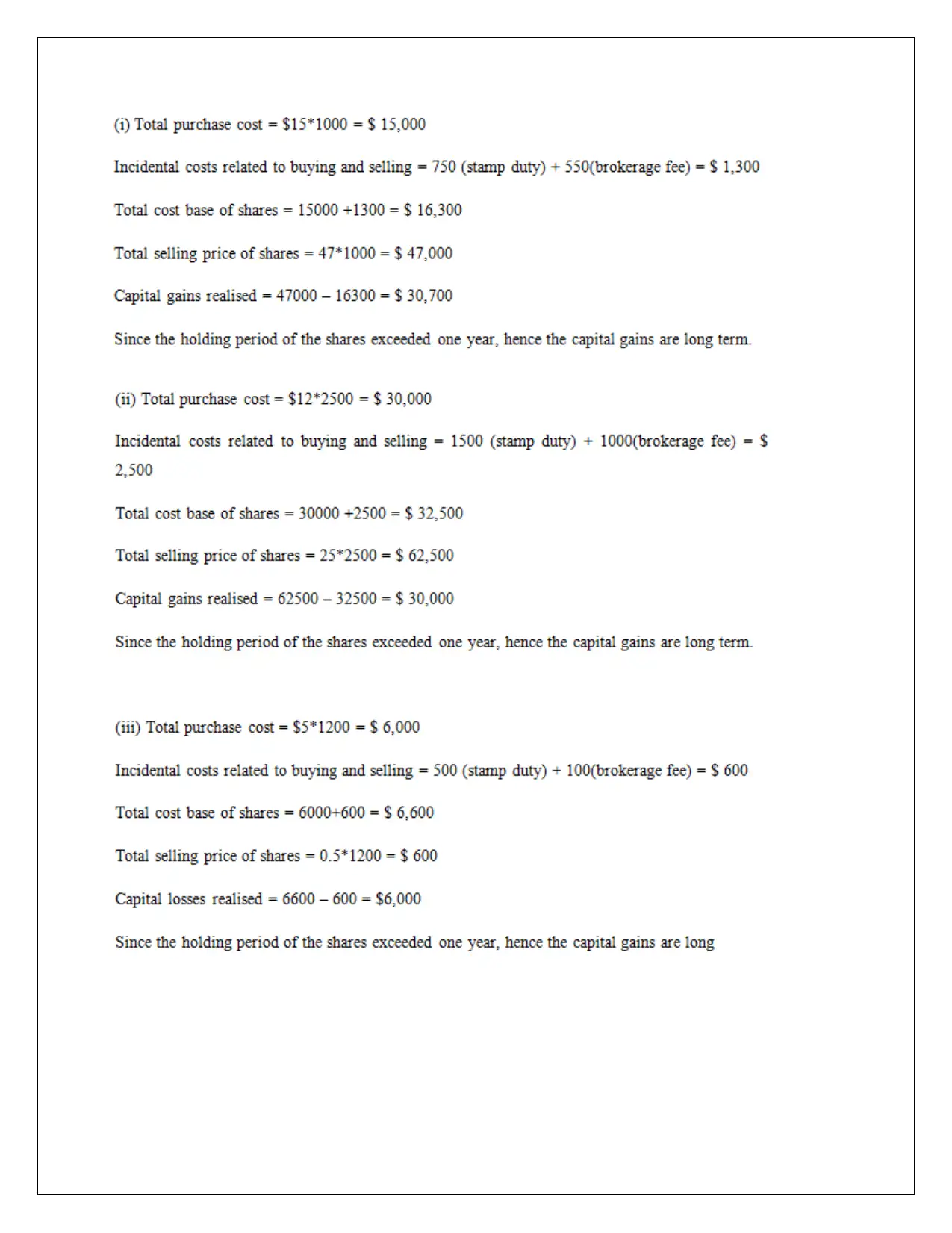
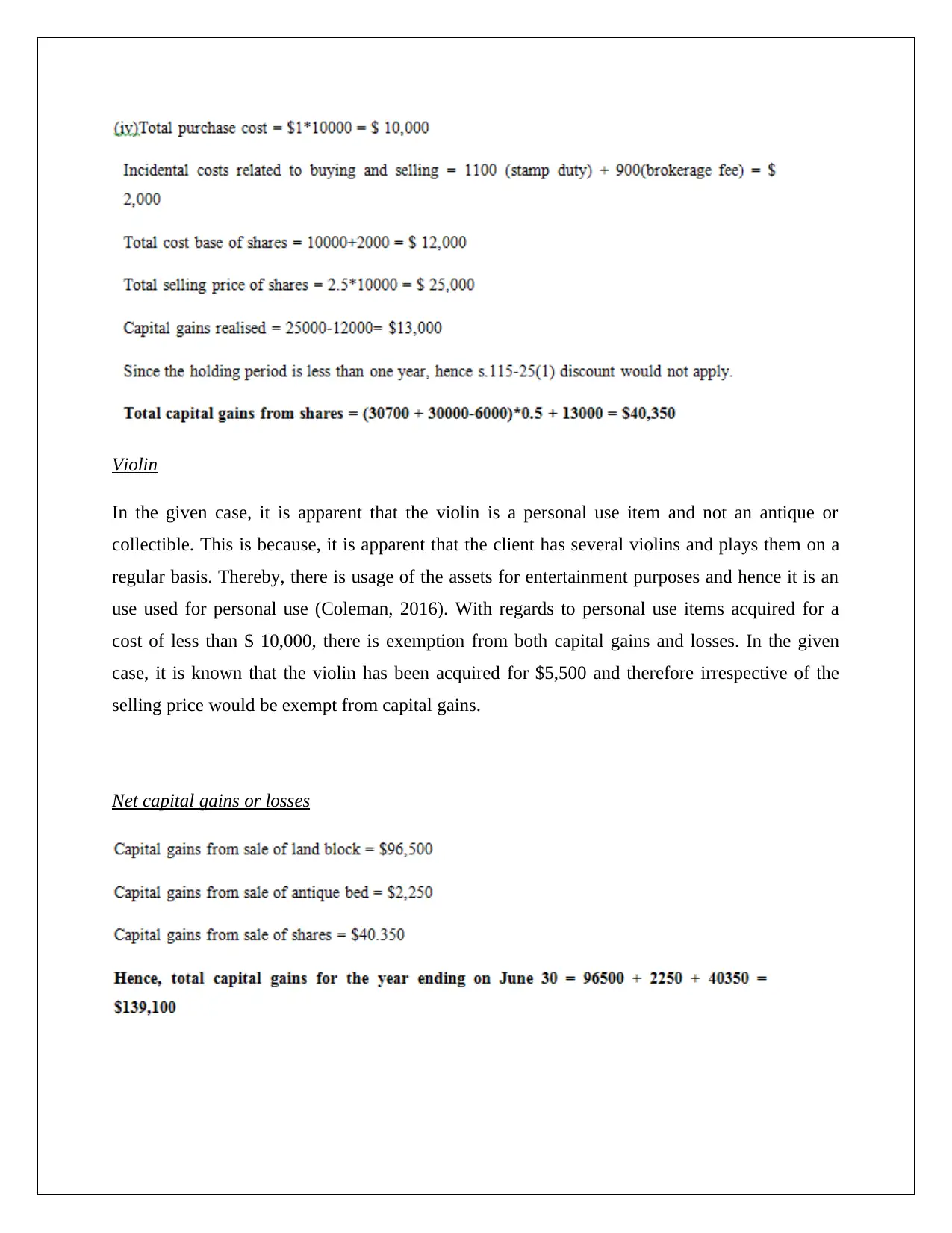
Violin
In the given case, it is apparent that the violin is a personal use item and not an antique or
collectible. This is because, it is apparent that the client has several violins and plays them on a
regular basis. Thereby, there is usage of the assets for entertainment purposes and hence it is an
use used for personal use (Coleman, 2016). With regards to personal use items acquired for a
cost of less than $ 10,000, there is exemption from both capital gains and losses. In the given
case, it is known that the violin has been acquired for $5,500 and therefore irrespective of the
selling price would be exempt from capital gains.
Net capital gains or losses
In the given case, it is apparent that the violin is a personal use item and not an antique or
collectible. This is because, it is apparent that the client has several violins and plays them on a
regular basis. Thereby, there is usage of the assets for entertainment purposes and hence it is an
use used for personal use (Coleman, 2016). With regards to personal use items acquired for a
cost of less than $ 10,000, there is exemption from both capital gains and losses. In the given
case, it is known that the violin has been acquired for $5,500 and therefore irrespective of the
selling price would be exempt from capital gains.
Net capital gains or losses
⊘ This is a preview!⊘
Do you want full access?
Subscribe today to unlock all pages.

Trusted by 1+ million students worldwide
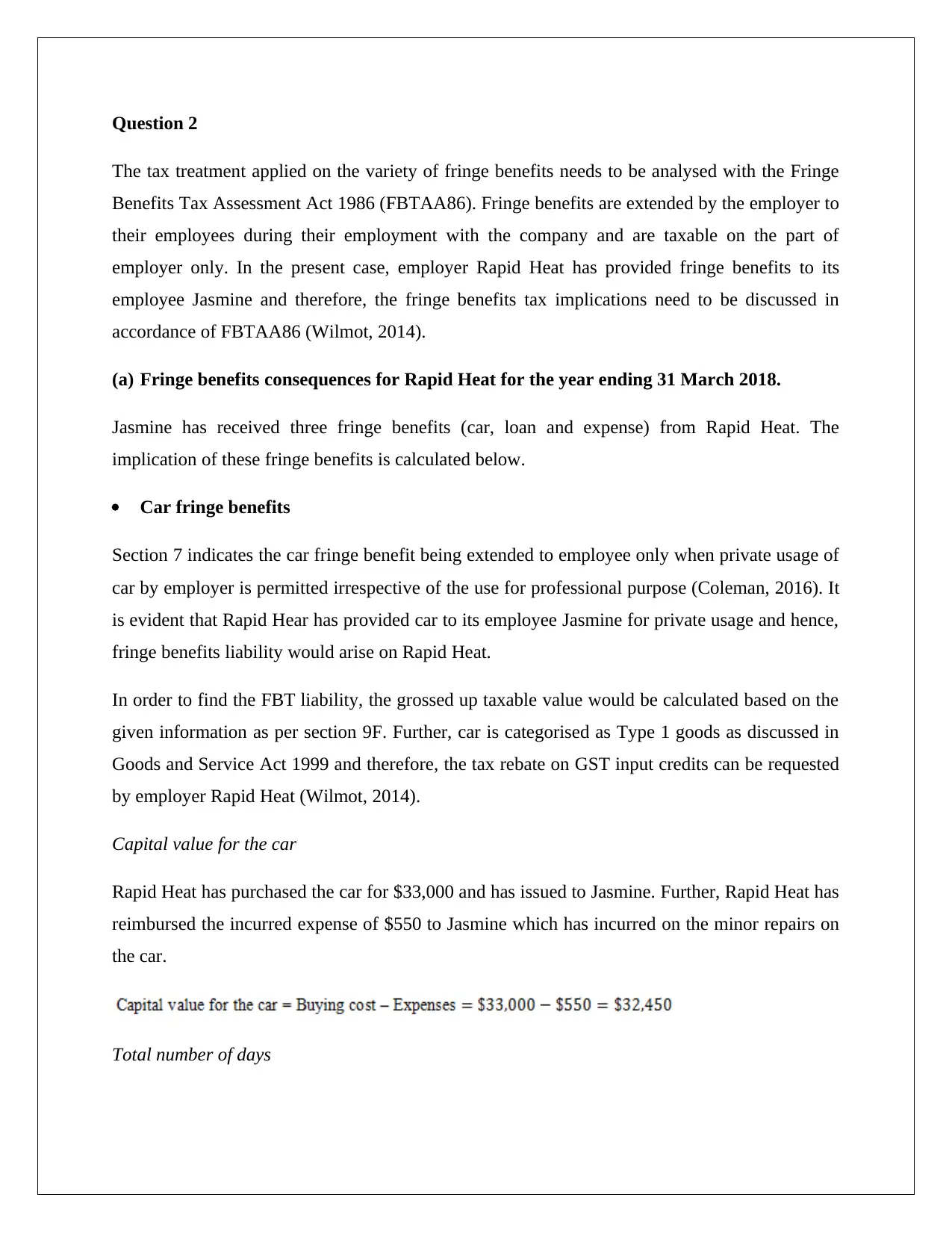
Question 2
The tax treatment applied on the variety of fringe benefits needs to be analysed with the Fringe
Benefits Tax Assessment Act 1986 (FBTAA86). Fringe benefits are extended by the employer to
their employees during their employment with the company and are taxable on the part of
employer only. In the present case, employer Rapid Heat has provided fringe benefits to its
employee Jasmine and therefore, the fringe benefits tax implications need to be discussed in
accordance of FBTAA86 (Wilmot, 2014).
(a) Fringe benefits consequences for Rapid Heat for the year ending 31 March 2018.
Jasmine has received three fringe benefits (car, loan and expense) from Rapid Heat. The
implication of these fringe benefits is calculated below.
Car fringe benefits
Section 7 indicates the car fringe benefit being extended to employee only when private usage of
car by employer is permitted irrespective of the use for professional purpose (Coleman, 2016). It
is evident that Rapid Hear has provided car to its employee Jasmine for private usage and hence,
fringe benefits liability would arise on Rapid Heat.
In order to find the FBT liability, the grossed up taxable value would be calculated based on the
given information as per section 9F. Further, car is categorised as Type 1 goods as discussed in
Goods and Service Act 1999 and therefore, the tax rebate on GST input credits can be requested
by employer Rapid Heat (Wilmot, 2014).
Capital value for the car
Rapid Heat has purchased the car for $33,000 and has issued to Jasmine. Further, Rapid Heat has
reimbursed the incurred expense of $550 to Jasmine which has incurred on the minor repairs on
the car.
Total number of days
The tax treatment applied on the variety of fringe benefits needs to be analysed with the Fringe
Benefits Tax Assessment Act 1986 (FBTAA86). Fringe benefits are extended by the employer to
their employees during their employment with the company and are taxable on the part of
employer only. In the present case, employer Rapid Heat has provided fringe benefits to its
employee Jasmine and therefore, the fringe benefits tax implications need to be discussed in
accordance of FBTAA86 (Wilmot, 2014).
(a) Fringe benefits consequences for Rapid Heat for the year ending 31 March 2018.
Jasmine has received three fringe benefits (car, loan and expense) from Rapid Heat. The
implication of these fringe benefits is calculated below.
Car fringe benefits
Section 7 indicates the car fringe benefit being extended to employee only when private usage of
car by employer is permitted irrespective of the use for professional purpose (Coleman, 2016). It
is evident that Rapid Hear has provided car to its employee Jasmine for private usage and hence,
fringe benefits liability would arise on Rapid Heat.
In order to find the FBT liability, the grossed up taxable value would be calculated based on the
given information as per section 9F. Further, car is categorised as Type 1 goods as discussed in
Goods and Service Act 1999 and therefore, the tax rebate on GST input credits can be requested
by employer Rapid Heat (Wilmot, 2014).
Capital value for the car
Rapid Heat has purchased the car for $33,000 and has issued to Jasmine. Further, Rapid Heat has
reimbursed the incurred expense of $550 to Jasmine which has incurred on the minor repairs on
the car.
Total number of days
Paraphrase This Document
Need a fresh take? Get an instant paraphrase of this document with our AI Paraphraser
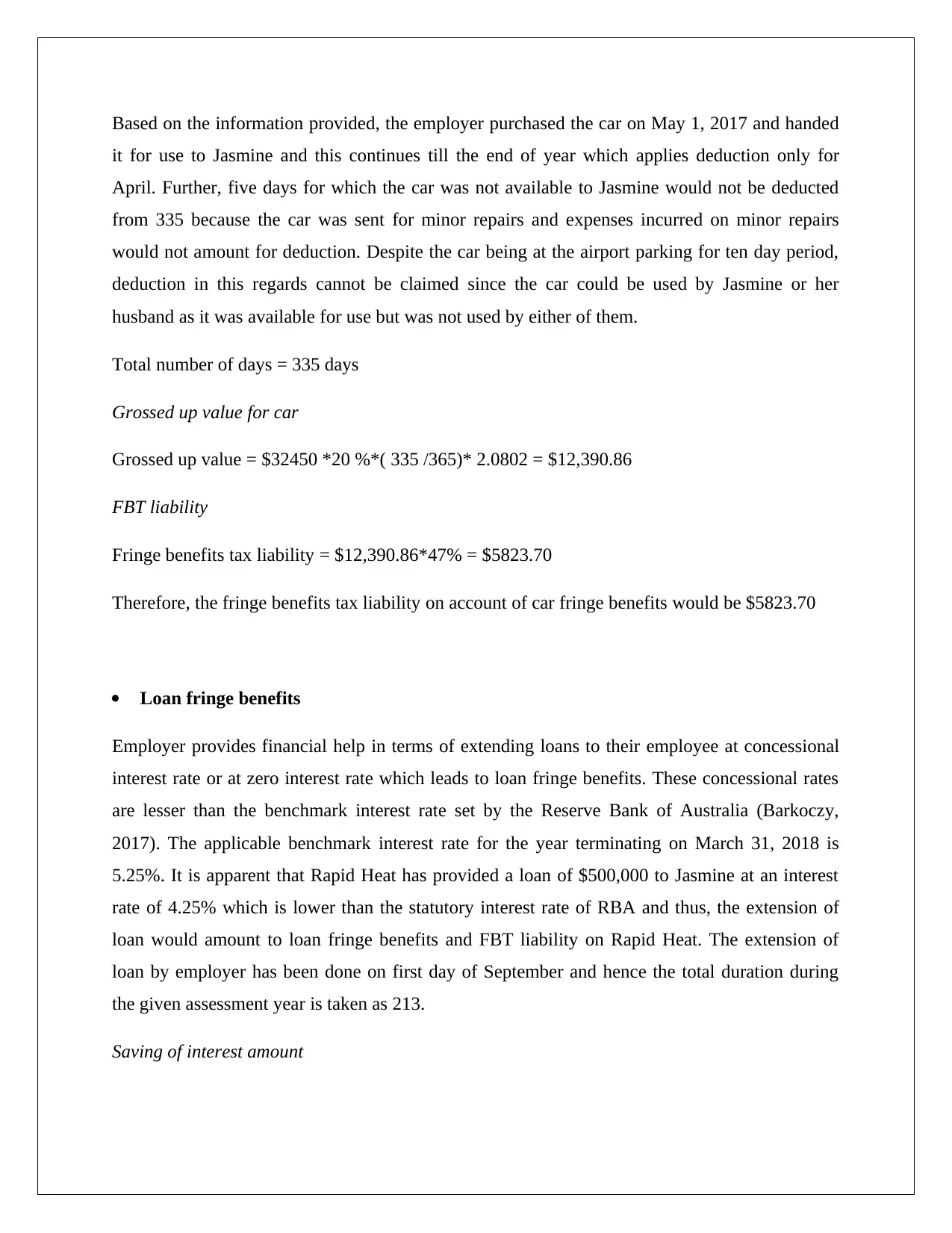
Based on the information provided, the employer purchased the car on May 1, 2017 and handed
it for use to Jasmine and this continues till the end of year which applies deduction only for
April. Further, five days for which the car was not available to Jasmine would not be deducted
from 335 because the car was sent for minor repairs and expenses incurred on minor repairs
would not amount for deduction. Despite the car being at the airport parking for ten day period,
deduction in this regards cannot be claimed since the car could be used by Jasmine or her
husband as it was available for use but was not used by either of them.
Total number of days = 335 days
Grossed up value for car
Grossed up value = $32450 *20 %*( 335 /365)* 2.0802 = $12,390.86
FBT liability
Fringe benefits tax liability = $12,390.86*47% = $5823.70
Therefore, the fringe benefits tax liability on account of car fringe benefits would be $5823.70
Loan fringe benefits
Employer provides financial help in terms of extending loans to their employee at concessional
interest rate or at zero interest rate which leads to loan fringe benefits. These concessional rates
are lesser than the benchmark interest rate set by the Reserve Bank of Australia (Barkoczy,
2017). The applicable benchmark interest rate for the year terminating on March 31, 2018 is
5.25%. It is apparent that Rapid Heat has provided a loan of $500,000 to Jasmine at an interest
rate of 4.25% which is lower than the statutory interest rate of RBA and thus, the extension of
loan would amount to loan fringe benefits and FBT liability on Rapid Heat. The extension of
loan by employer has been done on first day of September and hence the total duration during
the given assessment year is taken as 213.
Saving of interest amount
it for use to Jasmine and this continues till the end of year which applies deduction only for
April. Further, five days for which the car was not available to Jasmine would not be deducted
from 335 because the car was sent for minor repairs and expenses incurred on minor repairs
would not amount for deduction. Despite the car being at the airport parking for ten day period,
deduction in this regards cannot be claimed since the car could be used by Jasmine or her
husband as it was available for use but was not used by either of them.
Total number of days = 335 days
Grossed up value for car
Grossed up value = $32450 *20 %*( 335 /365)* 2.0802 = $12,390.86
FBT liability
Fringe benefits tax liability = $12,390.86*47% = $5823.70
Therefore, the fringe benefits tax liability on account of car fringe benefits would be $5823.70
Loan fringe benefits
Employer provides financial help in terms of extending loans to their employee at concessional
interest rate or at zero interest rate which leads to loan fringe benefits. These concessional rates
are lesser than the benchmark interest rate set by the Reserve Bank of Australia (Barkoczy,
2017). The applicable benchmark interest rate for the year terminating on March 31, 2018 is
5.25%. It is apparent that Rapid Heat has provided a loan of $500,000 to Jasmine at an interest
rate of 4.25% which is lower than the statutory interest rate of RBA and thus, the extension of
loan would amount to loan fringe benefits and FBT liability on Rapid Heat. The extension of
loan by employer has been done on first day of September and hence the total duration during
the given assessment year is taken as 213.
Saving of interest amount
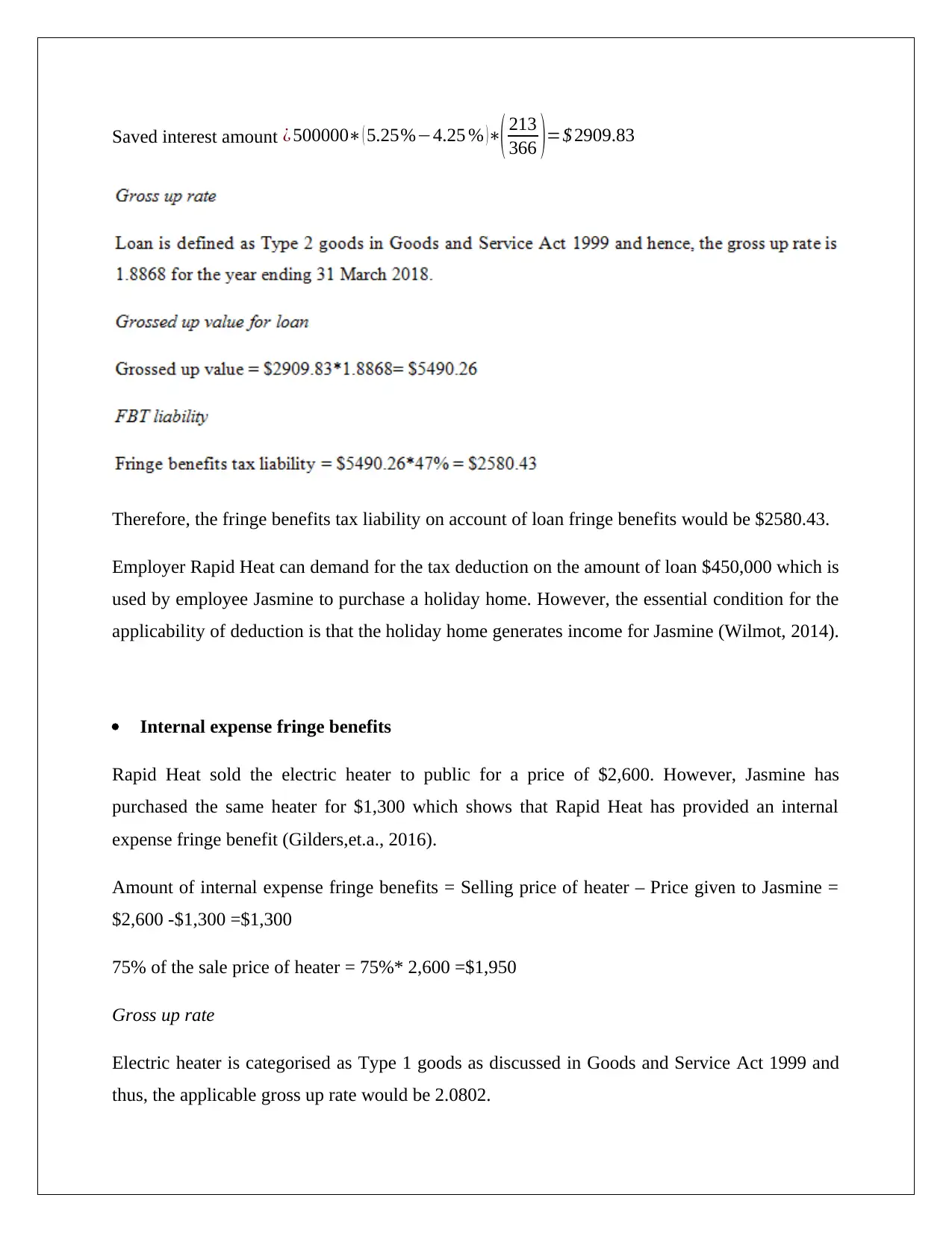
Saved interest amount ¿ 500000∗ ( 5.25%−4.25 % )∗( 213
366 )=$ 2909.83
Therefore, the fringe benefits tax liability on account of loan fringe benefits would be $2580.43.
Employer Rapid Heat can demand for the tax deduction on the amount of loan $450,000 which is
used by employee Jasmine to purchase a holiday home. However, the essential condition for the
applicability of deduction is that the holiday home generates income for Jasmine (Wilmot, 2014).
Internal expense fringe benefits
Rapid Heat sold the electric heater to public for a price of $2,600. However, Jasmine has
purchased the same heater for $1,300 which shows that Rapid Heat has provided an internal
expense fringe benefit (Gilders,et.a., 2016).
Amount of internal expense fringe benefits = Selling price of heater – Price given to Jasmine =
$2,600 -$1,300 =$1,300
75% of the sale price of heater = 75%* 2,600 =$1,950
Gross up rate
Electric heater is categorised as Type 1 goods as discussed in Goods and Service Act 1999 and
thus, the applicable gross up rate would be 2.0802.
366 )=$ 2909.83
Therefore, the fringe benefits tax liability on account of loan fringe benefits would be $2580.43.
Employer Rapid Heat can demand for the tax deduction on the amount of loan $450,000 which is
used by employee Jasmine to purchase a holiday home. However, the essential condition for the
applicability of deduction is that the holiday home generates income for Jasmine (Wilmot, 2014).
Internal expense fringe benefits
Rapid Heat sold the electric heater to public for a price of $2,600. However, Jasmine has
purchased the same heater for $1,300 which shows that Rapid Heat has provided an internal
expense fringe benefit (Gilders,et.a., 2016).
Amount of internal expense fringe benefits = Selling price of heater – Price given to Jasmine =
$2,600 -$1,300 =$1,300
75% of the sale price of heater = 75%* 2,600 =$1,950
Gross up rate
Electric heater is categorised as Type 1 goods as discussed in Goods and Service Act 1999 and
thus, the applicable gross up rate would be 2.0802.
⊘ This is a preview!⊘
Do you want full access?
Subscribe today to unlock all pages.

Trusted by 1+ million students worldwide
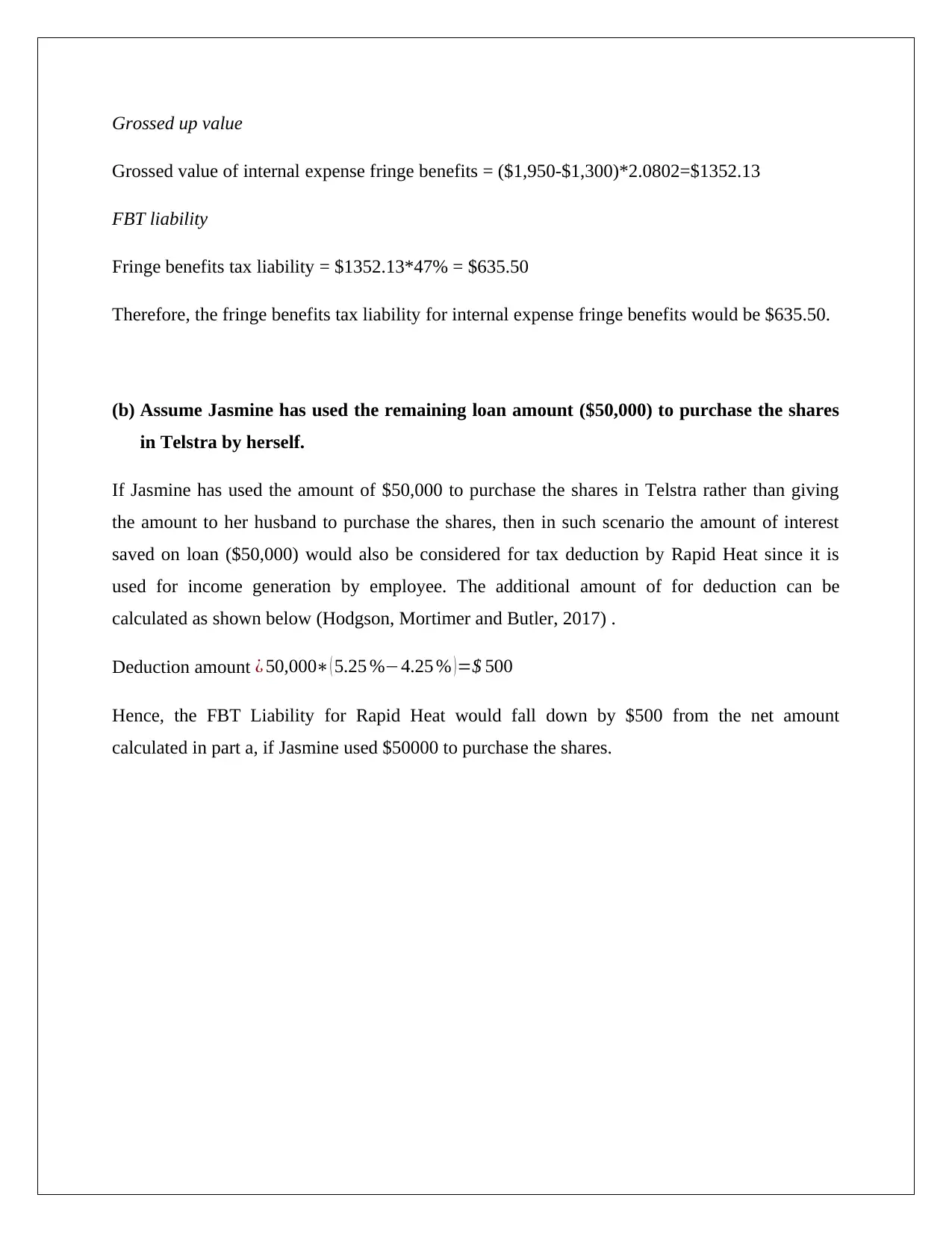
Grossed up value
Grossed value of internal expense fringe benefits = ($1,950-$1,300)*2.0802=$1352.13
FBT liability
Fringe benefits tax liability = $1352.13*47% = $635.50
Therefore, the fringe benefits tax liability for internal expense fringe benefits would be $635.50.
(b) Assume Jasmine has used the remaining loan amount ($50,000) to purchase the shares
in Telstra by herself.
If Jasmine has used the amount of $50,000 to purchase the shares in Telstra rather than giving
the amount to her husband to purchase the shares, then in such scenario the amount of interest
saved on loan ($50,000) would also be considered for tax deduction by Rapid Heat since it is
used for income generation by employee. The additional amount of for deduction can be
calculated as shown below (Hodgson, Mortimer and Butler, 2017) .
Deduction amount ¿ 50,000∗ ( 5.25 %−4.25 % )=$ 500
Hence, the FBT Liability for Rapid Heat would fall down by $500 from the net amount
calculated in part a, if Jasmine used $50000 to purchase the shares.
Grossed value of internal expense fringe benefits = ($1,950-$1,300)*2.0802=$1352.13
FBT liability
Fringe benefits tax liability = $1352.13*47% = $635.50
Therefore, the fringe benefits tax liability for internal expense fringe benefits would be $635.50.
(b) Assume Jasmine has used the remaining loan amount ($50,000) to purchase the shares
in Telstra by herself.
If Jasmine has used the amount of $50,000 to purchase the shares in Telstra rather than giving
the amount to her husband to purchase the shares, then in such scenario the amount of interest
saved on loan ($50,000) would also be considered for tax deduction by Rapid Heat since it is
used for income generation by employee. The additional amount of for deduction can be
calculated as shown below (Hodgson, Mortimer and Butler, 2017) .
Deduction amount ¿ 50,000∗ ( 5.25 %−4.25 % )=$ 500
Hence, the FBT Liability for Rapid Heat would fall down by $500 from the net amount
calculated in part a, if Jasmine used $50000 to purchase the shares.
Paraphrase This Document
Need a fresh take? Get an instant paraphrase of this document with our AI Paraphraser
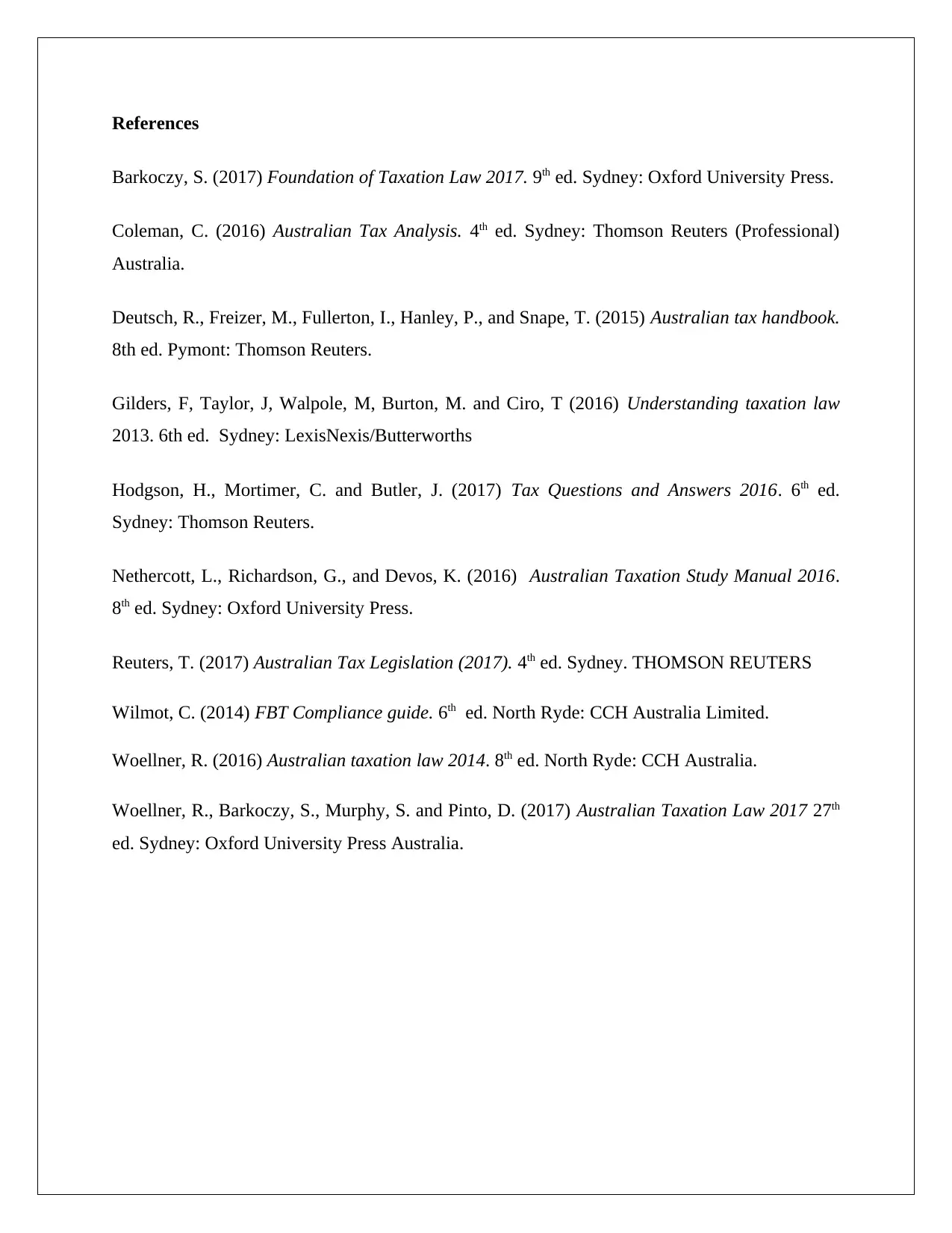
References
Barkoczy, S. (2017) Foundation of Taxation Law 2017. 9th ed. Sydney: Oxford University Press.
Coleman, C. (2016) Australian Tax Analysis. 4th ed. Sydney: Thomson Reuters (Professional)
Australia.
Deutsch, R., Freizer, M., Fullerton, I., Hanley, P., and Snape, T. (2015) Australian tax handbook.
8th ed. Pymont: Thomson Reuters.
Gilders, F, Taylor, J, Walpole, M, Burton, M. and Ciro, T (2016) Understanding taxation law
2013. 6th ed. Sydney: LexisNexis/Butterworths
Hodgson, H., Mortimer, C. and Butler, J. (2017) Tax Questions and Answers 2016. 6th ed.
Sydney: Thomson Reuters.
Nethercott, L., Richardson, G., and Devos, K. (2016) Australian Taxation Study Manual 2016.
8th ed. Sydney: Oxford University Press.
Reuters, T. (2017) Australian Tax Legislation (2017). 4th ed. Sydney. THOMSON REUTERS
Wilmot, C. (2014) FBT Compliance guide. 6th ed. North Ryde: CCH Australia Limited.
Woellner, R. (2016) Australian taxation law 2014. 8th ed. North Ryde: CCH Australia.
Woellner, R., Barkoczy, S., Murphy, S. and Pinto, D. (2017) Australian Taxation Law 2017 27th
ed. Sydney: Oxford University Press Australia.
Barkoczy, S. (2017) Foundation of Taxation Law 2017. 9th ed. Sydney: Oxford University Press.
Coleman, C. (2016) Australian Tax Analysis. 4th ed. Sydney: Thomson Reuters (Professional)
Australia.
Deutsch, R., Freizer, M., Fullerton, I., Hanley, P., and Snape, T. (2015) Australian tax handbook.
8th ed. Pymont: Thomson Reuters.
Gilders, F, Taylor, J, Walpole, M, Burton, M. and Ciro, T (2016) Understanding taxation law
2013. 6th ed. Sydney: LexisNexis/Butterworths
Hodgson, H., Mortimer, C. and Butler, J. (2017) Tax Questions and Answers 2016. 6th ed.
Sydney: Thomson Reuters.
Nethercott, L., Richardson, G., and Devos, K. (2016) Australian Taxation Study Manual 2016.
8th ed. Sydney: Oxford University Press.
Reuters, T. (2017) Australian Tax Legislation (2017). 4th ed. Sydney. THOMSON REUTERS
Wilmot, C. (2014) FBT Compliance guide. 6th ed. North Ryde: CCH Australia Limited.
Woellner, R. (2016) Australian taxation law 2014. 8th ed. North Ryde: CCH Australia.
Woellner, R., Barkoczy, S., Murphy, S. and Pinto, D. (2017) Australian Taxation Law 2017 27th
ed. Sydney: Oxford University Press Australia.
1 out of 11
Related Documents
Your All-in-One AI-Powered Toolkit for Academic Success.
+13062052269
info@desklib.com
Available 24*7 on WhatsApp / Email
![[object Object]](/_next/static/media/star-bottom.7253800d.svg)
Unlock your academic potential
Copyright © 2020–2026 A2Z Services. All Rights Reserved. Developed and managed by ZUCOL.





